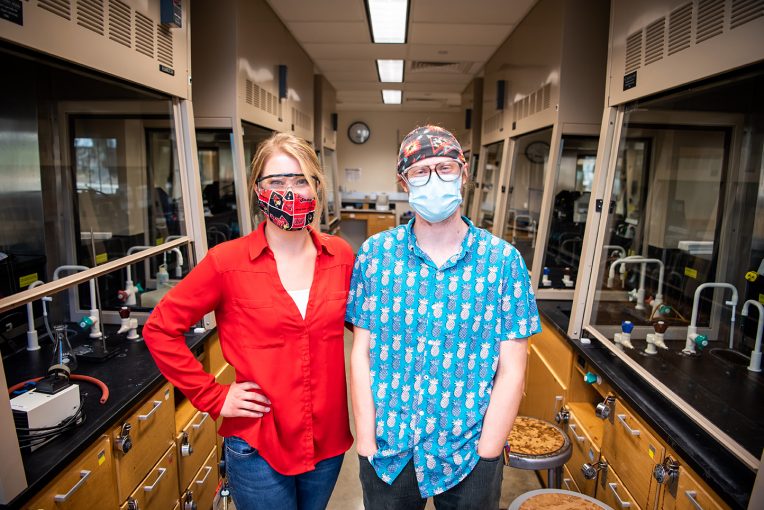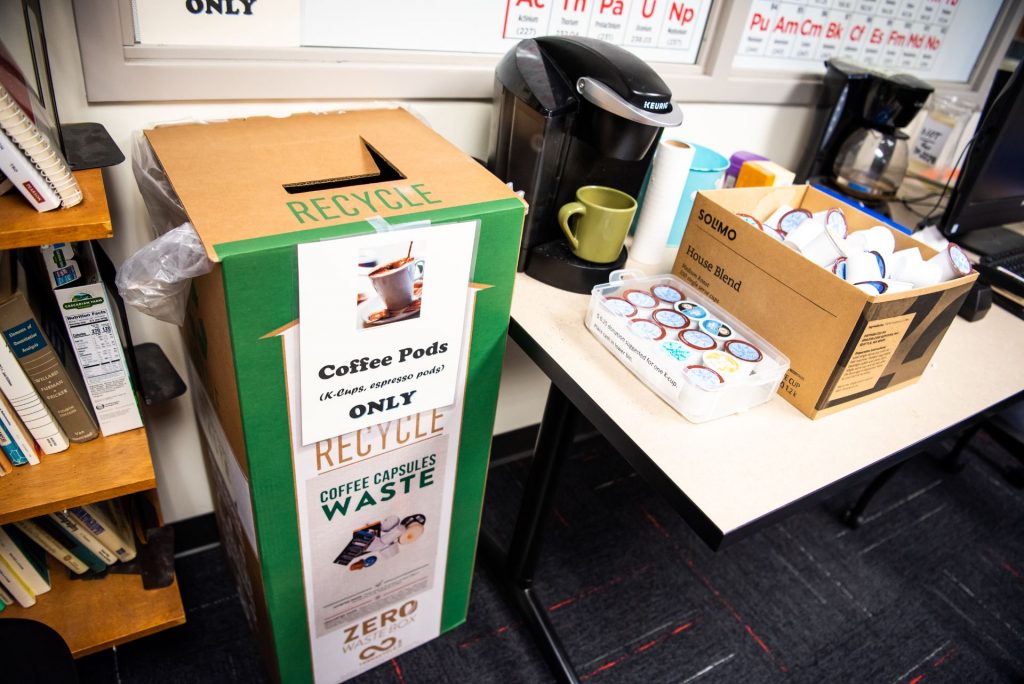The Department of Chemistry’s stockroom is a small, centralized space in the Science Laboratory Building. During a typical workday, stockroom manager Aly Hearn ’13 prepares teaching labs by measuring chemicals to the correct quantities and diluting them to the correct concentration. It can be tedious work, but once that is done, Hearn has the chance to put time into another passion of hers: sustainability.
The Illinois State alum was hired as an assistant in the stockroom in 2016. Now, as manager, she lessens the department’s environmental footprint.
“I am an advocate for reduce, reuse, recycle, in that order. You should reduce where you can, and then, if not, reuse it, and then, as a last resort, recycle it,” Hearn said, “I have a strong connection to this place, having been here for so many years, and I’ve always wanted to make a difference in the world, so I feel like giving back to the students at my alma mater is kind of an extra special thing.”
In collaboration with the Office of Sustainability and students and faculty in the Department of Chemistry, Hearn has made great strides toward greener practices, and she is most proud of the engagement she has seen from students in the department.
“I’m impressed with the reception that I have had,” Hearn said. “I think that our current students—undergraduate and graduate—feel that sustainability is part of their upbringing in their lives. I think that’s something that’s ingrained almost into our students, and something that they’re always looking to do.”
Reduce, reuse, recycle: Green chemistry
The stockroom has a centralized inventory system for its materials, so the department’s sustainability efforts begin with purchasing products. Rather than buying everything in bulk, like had been done in the past, the department now purchases only what they need, particularly when it comes to items with a shorter shelf life, as anything unused must be treated as waste.
Hearn is also incorporating “green chemistry,” or sustainable chemistry, into teaching labs. Green chemistry reduces the use of hazardous materials in the application of chemicals in lab work. If the materials used in teaching labs are nonhazardous, anything unused can simply go down the drain, eliminating the need for large hazardous waste drums.
To lessen its environmental footprint further, the stockroom condenses any hazardous waste that is created. In the past, waste was stored and disposed of in one-gallon bottles, but now any waste created in the labs is collected into one 30-gallon drum. This method not only reduces the impact of hazardous waste, but also saves the department money, as the cost to dispose of the waste is determined by the number of containers used.
“I am an advocate for reduce, reuse, recycle, in that order. You should reduce where you can, and then, if not, reuse it, and, then as a last resort, recycle it.”
Aly Hearn
Hearn reuses materials whenever possible. Empty containers are used for storage: Chemical buckets are repurposed as cleanup bins, and even shipping materials find a second life in the stockroom. Other departments have taken note.
“We get a lot of shipments, and because of the nature of what’s being shipped, it’s usually packed in there with a lot of extra materials. So we save those for whenever we need to put things in storage or need to send off things that are breakable,” Hearn said. “I believe the IT department just came and took a ton of my stuff because they had things to put into storage. People are starting to learn that if they need something, come to Aly.”
New vacuum pumps cut down water waste
Vacuum pumps are used to quickly clean and dry materials in the stockroom. The Venturi-style vacuum used in the past created excess water waste, as the fast-flowing water needed to create the suction for the vacuum sent gallons of water down the drain. With funding acquired from the Office of Sustainability, the department was able to buy five new rotary evaporator vacuum pumps for the stockroom and teaching labs. These have already allowed the Chemistry Department to save an estimated 429,000 of gallons of water a year.
The idea to make the change came about when David Kukla ’20, then a junior Chemistry major and stockroom assistant and now a graduate student, noted the overall inefficiency of the original pumps.
“They didn’t get down to the appropriate pressures to actually distill off the solvent, so we were actually running the instrument for much longer,” Kukla said. “In addition, the vacuum strength wasn’t as strong with these particular aspirators, so when we switched out the vacuum pumps, they could get to the right pressure, and make the process faster.”
Already the time spent cleaning items in the lab has decreased dramatically, from an estimated 30 minutes to just two or three minutes per instrument with the new model.
The new vacuums also give students in teaching labs a better idea of what professional setups look like. “The equipment that we’re using in the teaching lab should reflect the equipment that we use in research. We use the higher vacuums, and more powerful instruments, so I think this is a much more beneficial way of engaging students and getting them interested in the process,” Kukla said.
Linking science, sustainability, and art
For Kukla, an eye for sustainability runs in the family. When he first started in the stockroom in spring 2019, Kukla noticed that the large metal drums used to store acetone were sent to the junkyard when empty. So instead he decided to pass the empty drums down to his father, Chris Kukla, to use in his artwork.
Chris Kukla is a ceramicist who utilizes a process called Naked Raku, which involves removing pieces of ceramic from the kiln while they are still hot and immediately placing the body into sawdust. In this process, the kilns are heated to around 1,500 degrees Fahrenheit, which can damage the structure of the metal after a few uses. The department makes use of almost 100 gallons of acetone monthly, leaving a hefty supply of empty drums, which Kukla’s father repurposes as kilns for his work.
Other artists now turn to the Kuklas for drums to repurpose for their own work.
“So it’s a way to reuse, and kind of bridge that gap between art and science,” Kukla said, “Because I think, commonly, we separate the two sides of science and art, but I have always felt like the best scientists are artists, and the best artists are scientists, and it’s very interesting to intertwine the thinking process of solving problems and also being creative. A barrel that was used for acetone has a second life, and then you create spaces where people can communicate about art.”
Limiting office waste with TerraCycle
The department’s sustainability practices do not end in the stockroom. Eco-friendly measures are taken to recycle more common items as well.
Ginger Beer is likely the first person one encounters when walking into the department office in Julian Hall. As the office support specialist, her frontline knowledge of what is used daily pushed her to institute more environmentally friendly measures. “I just was seeing all the people that come in and out of here to get whiteboard markers, and we go through boxes and boxes of them, and I thought, ‘All those are just ending up in the garbage,’” Beer said.
After attending the Office of Sustainability Zero Waste “The Green Team Forum” in January 2020, Beer was motivated to eliminate unnecessary waste in the office. She decided to collaborate with the TerraCycle program, an initiative that allows individuals to package and send hard-to-recycle waste to their recycling plants rather than throwing them in the trash.
Participants in the program purchase “Zero Waste” bins that serve as receptacles for different recyclable goods. In the department office, the bin is used for coffee pods. Writing instruments and other daily office items are also collected and sent to TerraCycle as a part of its partnership with Bic. Once the bins are full, they are sent to one of the two TerraCycle drop-off locations in Bloomington.
Beer set up four bins purchased by the department in high traffic areas of Julian Hall. Already she has noticed engagement from students and faculty, as boxes fill with markers and other office supplies.
“One of the offices over in a different building actually has started to send me packets of markers through interoffice mail,” Beer said. “I went over and picked up a box one time, but now most of the time they’ll just fill up an office envelope and send it to me and I just put it in the bigger box to go.”
When asked why she started the project, she said she wanted to do her part to eliminate waste. “There is only one planet,” Beer said, “It’s not very hard to stick a box in a room with a little sign that says, recycle. A little box like that can make a difference.”





